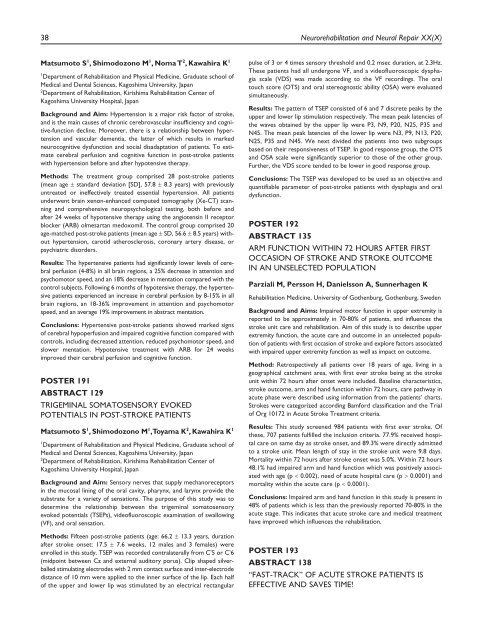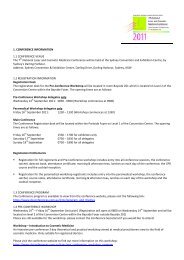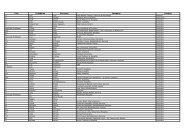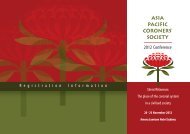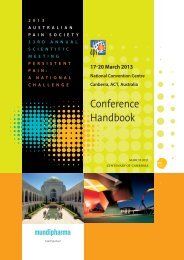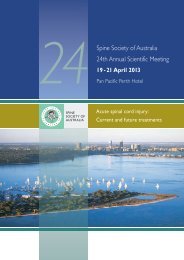WCNR 2012 Poster Abstracts - DC Conferences
WCNR 2012 Poster Abstracts - DC Conferences
WCNR 2012 Poster Abstracts - DC Conferences
You also want an ePaper? Increase the reach of your titles
YUMPU automatically turns print PDFs into web optimized ePapers that Google loves.
38 Neurorehabilitation and Neural Repair XX(X)Matsumoto S 1 , Shimodozono M 1 , Noma T 2 , Kawahira K 11 Department of Rehabilitation and Physical Medicine, Graduate school ofMedical and Dental Sciences, Kagoshima University, Japan2 Department of Rehabilitation, Kirishima Rehabilitation Center ofKagoshima University Hospital, JapanBackground and Aim: Hypertension is a major risk factor of stroke,and is the main causes of chronic cerebrovascular insufficiency and cognitive-functiondecline. Moreover, there is a relationship between hypertensionand vascular dementia, the latter of which results in markedneurocognitive dysfunction and social disadaptation of patients. To estimatecerebral perfusion and cognitive function in post-stroke patientswith hypertension before and after hypotensive therapy.Methods: The treatment group comprised 28 post-stroke patients(mean age standard deviation [SD], 57.8 8.3 years) with previouslyuntreated or ineffectively treated essential hypertension. All patientsunderwent brain xenon-enhanced computed tomography (Xe-CT) scanningand comprehensive neuropsychological testing, both before andafter 24 weeks of hypotensive therapy using the angiotensin II receptorblocker (ARB) olmesartan medoxomil. The control group comprised 20age-matched post-stroke patients (mean age SD, 56.6 8.5 years) withouthypertension, carotid atherosclerosis, coronary artery disease, orpsychiatric disorders.Results: The hypertensive patients had significantly lower levels of cerebralperfusion (4-8%) in all brain regions, a 25% decrease in attention andpsychomotor speed, and an 18% decrease in mentation compared with thecontrol subjects. Following 6 months of hypotensive therapy, the hypertensivepatients experienced an increase in cerebral perfusion by 8-15% in allbrain regions, an 18-36% improvement in attention and psychomotorspeed, and an average 19% improvement in abstract mentation.Conclusions: Hypertensive post-stroke patients showed marked signsof cerebral hypoperfusion and impaired cognitive function compared withcontrols, including decreased attention, reduced psychomotor speed, andslower mentation. Hypotensive treatment with ARB for 24 weeksimproved their cerebral perfusion and cognitive function.POSTER 191ABSTRACT 129TRIGEMINAL SOMATOSENSORY EVOKEDPOTENTIALS IN POST-STROKE PATIENTSMatsumoto S 1 , Shimodozono M 1 , Toyama K 2 , Kawahira K 11 Department of Rehabilitation and Physical Medicine, Graduate school ofMedical and Dental Sciences, Kagoshima University, Japan2 Department of Rehabilitation, Kirishima Rehabilitation Center ofKagoshima University Hospital, JapanBackground and Aim: Sensory nerves that supply mechanoreceptorsin the mucosal lining of the oral cavity, pharynx, and larynx provide thesubstrate for a variety of sensations. The purpose of this study was todetermine the relationship between the trigeminal somatosensoryevoked potentials (TSEPs), videofluoroscopic examination of swallowing(VF), and oral sensation.Methods: Fifteen post-stroke patients (age: 66.2 13.3 years, durationafter stroke onset: 17.5 7.6 weeks, 12 males and 3 females) wereenrolled in this study. TSEP was recorded contralaterally from C’5 or C’6(midpoint between Cz and external auditory porus). Clip shaped silverballedstimulating electrodes with 2 mm contact surface and inter-electrodedistance of 10 mm were applied to the inner surface of the lip. Each halfof the upper and lower lip was stimulated by an electrical rectangularpulse of 3 or 4 times sensory threshold and 0.2 msec duration, at 2.3Hz.These patients had all undergone VF, and a videofluoroscopic dysphagiascale (VDS) was made according to the VF recordings. The oraltouch score (OTS) and oral stereognostic ability (OSA) were evaluatedsimultaneously.Results: The pattern of TSEP consisted of 6 and 7 discrete peaks by theupper and lower lip stimulation respectively. The mean peak latencies ofthe waves obtained by the upper lip were P3, N9, P20, N25, P35 andN45. The mean peak latencies of the lower lip were N3, P9, N13, P20,N25, P35 and N45. We next divided the patients into two subgroupsbased on their responsiveness of TSEP. In good response group, the OTSand OSA scale were significantly superior to those of the other group.Further, the VDS score tended to be lower in good response group.Conclusions: The TSEP was developed to be used as an objective andquantifiable parameter of post-stroke patients with dysphagia and oraldysfunction.POSTER 192ABSTRACT 135ARM FUNCTION WITHIN 72 HOURS AFTER FIRSTOCCASION OF STROKE AND STROKE OUTCOMEIN AN UNSELECTED POPULATIONParziali M, Persson H, Danielsson A, Sunnerhagen KRehabilitation Medicine, University of Gothenburg, Gothenburg, SwedenBackground and Aims: Impaired motor function in upper extremity isreported to be approximately in 70-80% of patients, and influences thestroke unit care and rehabilitation. Aim of this study is to describe upperextremity function, the acute care and outcome in an unselected populationof patients with first occasion of stroke and explore factors associatedwith impaired upper extremity function as well as impact on outcome.Method: Retrospectively all patients over 18 years of age, living in ageographical catchment area, with first ever stroke being at the strokeunit within 72 hours after onset were included. Baseline characteristics,stroke outcome, arm and hand function within 72 hours, care pathway inacute phase were described using information from the patients’ charts.Strokes were categorized according Bamford classification and the Trialof Org 10172 in Acute Stroke Treatment criteria.Results: This study screened 984 patients with first ever stroke. Ofthese, 707 patients fulfilled the inclusion criteria. 77.9% received hospitalcare on same day as stroke onset, and 89.3% were directly admittedto a stroke unit. Mean length of stay in the stroke unit were 9.8 days.Mortality within 72 hours after stroke onset was 5.0%. Within 72 hours48.1% had impaired arm and hand function which was positively associatedwith age (p 0.002), need of acute hospital care (p 0.0001) andmortality within the acute care (p 0.0001).Conclusions: Impaired arm and hand function in this study is present in48% of patients which is less than the previously reported 70-80% in theacute stage. This indicates that acute stroke care and medical treatmenthave improved which influences the rehabilitation.POSTER 193ABSTRACT 138“FAST-TRACK” OF ACUTE STROKE PATIENTS ISEFFECTIVE AND SAVES TIME!


